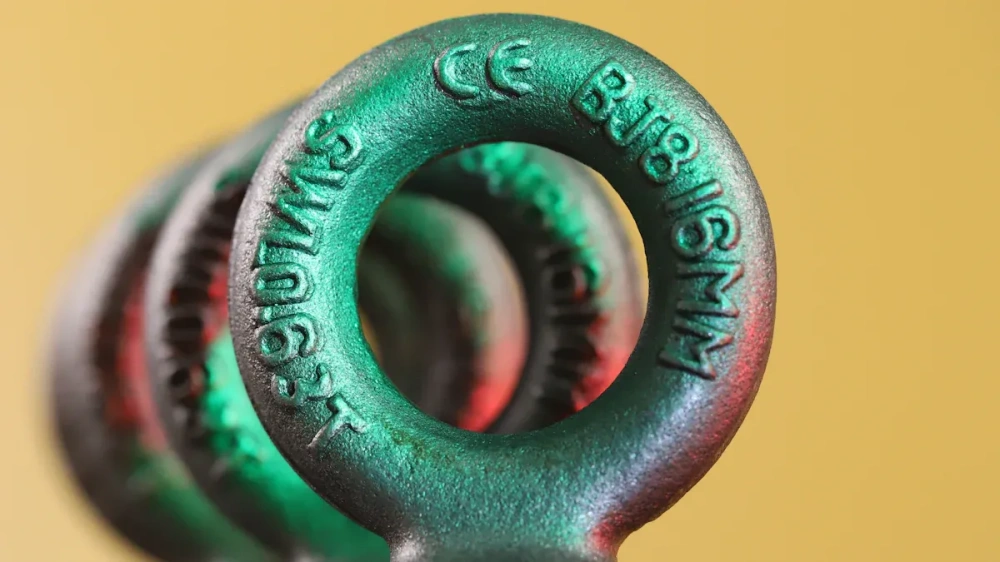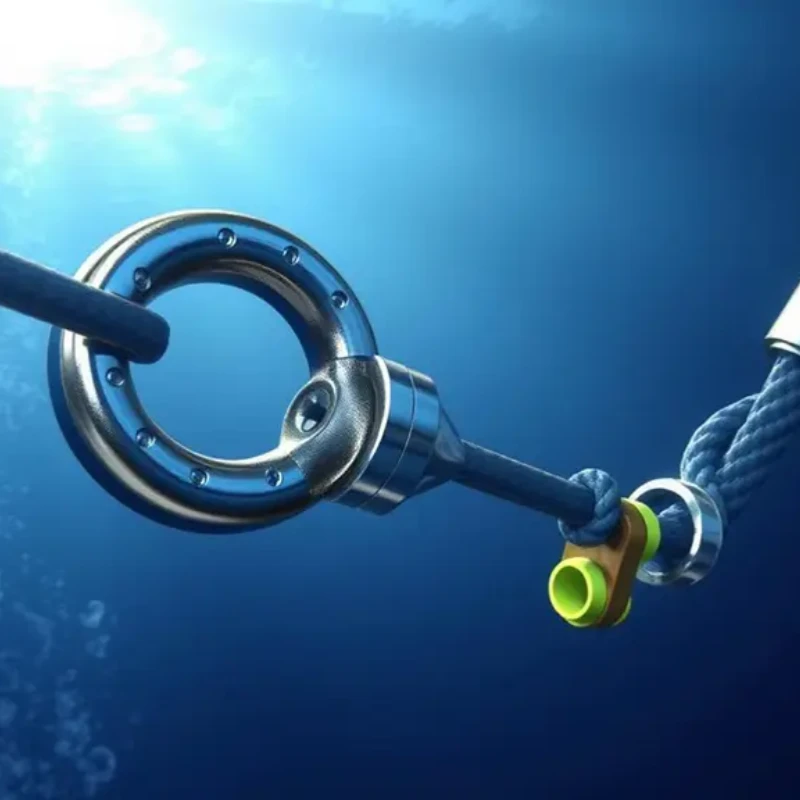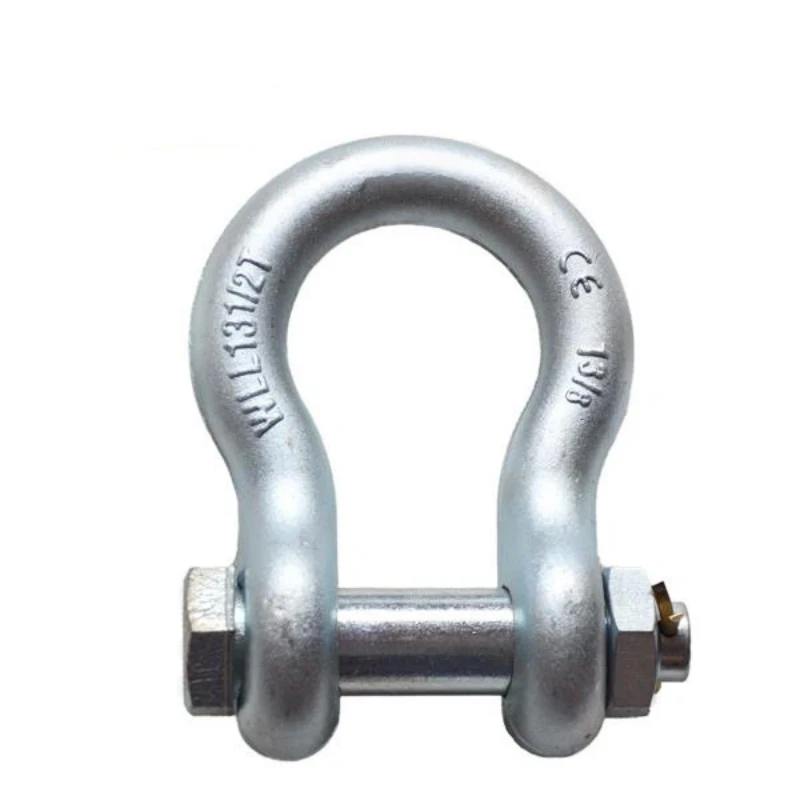Eye bolts serve as essential connectors in lifting and rigging. You rely on them to attach chains, ropes, or cables securely to loads. The main types include shouldered, non-shouldered, forged, bent, nut, machinery, and screw eye bolts. Each type has specific load and installation requirements.
Type of Eye Bolt | Description | Usage Considerations |
|---|---|---|
Shouldered Eye Bolts | Reduce bending stresses | Use for angular lifting; shoulder must be flush |
Non-Shouldered Eye Bolts | No shoulder, only for vertical lifts | Avoid side or angular loading |
Forged Eye Bolts | Stronger, hammered or pressed | Suitable for heavy-duty, in-line or angular loading |
Bent Eye Bolts | Bent rod, lighter-duty | Not for heavy or angular loads |
Nut Eye Bolts | Secured with a nut | Versatile, depends on design |
Machinery Eye Bolts | Threaded for engineered points | Handle angular loads up to 45° if shouldered |
Screw Eye Bolts | Screw with an eye, light applications | Not for overhead or heavy loads |
Powerful Machinery delivers certified solutions, including stainless steel eye bolts, trusted for strength and corrosion resistance. You gain practical advice here for selecting, installing, and maintaining eye bolts for lifting.
Key Takeaways
Choose the right type of eye bolt for your lifting task to ensure safety. Shouldered eye bolts are best for angular lifts, while non-shouldered types are only for vertical lifts.
Always check the working load limit (WLL) of eye bolts before use. Exceeding this limit can lead to dangerous failures during lifting operations.
Inspect eye bolts regularly for wear and damage. Remove any defective bolts from service immediately to maintain safety in lifting tasks.
Select eye bolts made from suitable materials for your environment. Stainless steel is ideal for corrosive settings, while forged steel offers strength for heavy loads.
Follow proper installation guidelines for eye bolts. Ensure the shoulder is flush against the load and tighten securely to prevent accidents.
Eye bolts for lifting
What are eye bolts?

You use eye bolts for lifting when you need a strong and secure anchor point. These components have a looped head and a threaded shank. You can attach chains, ropes, or cables to the loop.
Eye bolts for lifting play a key role in moving heavy loads safely. They help you connect lifting equipment to objects that need to be hoisted or secured. When you choose the right eyebolts, you make your lifting tasks safer and more efficient.
Key parts of eyebolts
Eyebolts have several important parts. The main section is the eye, which forms a closed loop. This loop holds the lifting device or rope. The shank is the straight, threaded part that you screw into a load or structure. Some eye bolts for lifting have a shoulder between the eye and the shank.
The shoulder helps reduce bending stress during angular lifts. You also find different thread types and lengths, which let you match the eyebolt to your specific lifting needs.
Material | Load Capacity (Safety Factor) | Standard |
|---|---|---|
High tensile steel | MBL = 5 x SWL | B.S. 3974 – Part 1 – 1974 |
Carbon steel, C15 | MBL = 4 x WLL | DIN 582 |
Forged, tempered steel | WLL indicated for lateral load | Quality class 8 |
Tip: Always check the material and thread type before using eye bolts for lifting. This ensures you meet safety standards and match the load requirements.
Common uses in lifting and rigging
You find eyebolts in many lifting and rigging tasks. They serve as anchor points for hoists and cranes in warehouses. You use them to secure loads during transport. In construction, you rely on eye bolts for lifting scaffolding and attaching safety nets.
They also help you with hoisting and pulling tasks by providing a stable connection for ropes or cables.
Lifting and rigging: Eye bolts for lifting give you a secure attachment point for heavy loads.
Securing loads: You can anchor devices to prevent movement during transport.
Construction and building: Use eyebolts to anchor scaffolding and safety equipment.
Material handling: Attach hoists and cranes for moving goods in industrial settings.
Hoisting and pulling: Provide stable points for ropes or cables in pulling operations.
Powerful Machinery stands out as a trusted provider of certified lifting hardware. You benefit from their high-quality eye bolts for lifting, which meet strict international standards. Their products help you complete lifting and rigging jobs with confidence and safety.
Types of eye bolts

When you choose eye bolts for lifting and rigging, you encounter many options. Each type of eyebolt serves a specific purpose and offers unique advantages. Understanding the different types of eye bolts helps you select the right one for your application and ensures safety during lifting.
Regular eye bolts
Regular eye bolts, sometimes called plain pattern eyebolts, have a simple design. You use them for vertical lifting only. These eyebolts do not have a shoulder, so they cannot handle side or angular loads. If you use them at an angle, they may bend or break. Always use regular eye bolts for straight-line pulls.
Feature | Regular Eye Bolt | Other Types (e.g., Shoulder Eye Bolt) |
|---|---|---|
Design | Non-shouldered, uses a nut | Usually shouldered for angular loads |
Load Direction | Vertical pulls only | Can handle angular loads |
Risk of Failure | Bends/breaks under side loading | More robust for various loading angles |
Recommended Use | Overhead lifting only | Versatile for different scenarios |
Tip: Regular eye bolts are not suitable for angular lifting. For side loads, always choose a shoulder eye bolt.
Shoulder eye bolts
Shoulder eye bolts, also known as shoulder pattern eyebolts, feature a shoulder between the eye and the shank. This design allows you to use them for both vertical and angular lifts.
The shoulder helps resist bending and adds strength during side loading. You must install the shoulder flush against the surface to ensure full load capacity.
Shoulder eye bolts can handle angular lifting due to their design.
The shoulder reduces bending stresses, making these eyebolts more versatile.
Non-shoulder eye bolts are not intended for any type of side loading.
Feature | Shoulder Eye Bolts | Non-Shoulder Eye Bolts |
|---|---|---|
Design | Has a shoulder | No shoulder |
Application | Angular and straight-line pulls | Vertical lifts only |
Load Handling | Reduces tension on the shank | Not for side loading |
Strength | Added strength for angular lifts | Reduced capacity for off-axis loads |
Machinery eye bolts
Machinery eye bolts are designed for heavy-duty lifting. You often find them with fully threaded shanks, making them ideal for attaching to machinery and equipment. These eyebolts offer high safety margins and can handle significant loads. You use them in manufacturing, construction, and shipping.
Advantage | Description |
|---|---|
Safety | High working load limit for reduced risk |
Versatility | Suitable for many environments |
Efficiency | Easy attachment for hooks or chains, speeds up lifting |
Nut eye bolts
Nut eye bolts have a threaded shank and require a nut for secure installation. You use them in the construction, marine, and transportation industries. These eyebolts are essential for lifting applications, but you must always check the working load limit. Never exceed the rated capacity, and remember that load angles affect lifting strength.
Nut eye bolts are common in construction and marine operations.
Always follow the working load limit to prevent accidents.
Inspect eyebolts for wear and corrosion before each use.
Proper installation is crucial for safety.
“Safety starts with the right choice of hardware.”
Screw eye bolts
Screw eye bolts have a pointed, threaded shank. You screw them directly into wood or other soft materials. These eyebolts are best for light-duty tasks, such as hanging cables or securing small loads. Do not use screw eye bolts for overhead lifting or heavy loads.
Lag eye bolts
Lag eye bolts are similar to screw eye bolts but have a lag screw thread. You use them for wood structures where you need a strong anchor point. Lag eye bolts are suitable for light to medium-duty lifting and securing tasks. They provide a reliable connection in timber and other soft materials.
Forged eye bolts
Forged eye bolts are made by shaping metal under high pressure. This process improves the grain structure, giving you superior strength and fatigue resistance. Forged eyebolts are ideal for demanding, heavy-duty lifting applications.
Forged eye bolts offer outstanding strength and durability.
The forging process includes heat treatment, quenching, and tempering for enhanced performance.
These eyebolts are more reliable than machined components in tough environments.
Formed and bent eye bolts
Formed and bent eye bolts are made by bending steel rods into a loop. You use them for lighter loads. These eyebolts are not load-rated and can fail by straightening out under stress.
Closed-end forged eyebolts with a shoulder are the only load-rated eyebolts. Always mount them against a flat surface or a washer to carry their rated load.
Failure Mode | Description |
|---|---|
Angular Pull Failure | An angular pull of 6 to 15 degrees can reduce the working load to 55 percent |
Wire eyebolts are not load-rated and fail by straightening, not breaking.
Dynamo eyebolts
Dynamo eyebolts have a unique design with a small collar between the eye and the screw thread. You use them for axial loading only.
These eyebolts were originally used in power generators and are typically used only a few times during the equipment’s life. They are made from hardened and tempered steel and come with certificates for quality assurance.
Feature | Description |
|---|---|
Design | Small collar, axial loading only |
Applications | Used in power generators, with limited use |
Material | Hardened and tempered steel |
Safety | High safety factor, certified |
Collared eyebolts
Collared eyebolts have a collar or shoulder that provides extra strength. You use them for both vertical and angular lifts. The collar helps distribute the load and reduces stress on the shank. Collared eyebolts are common in heavy lifting and rigging operations.
Eyebolts with a link
Eyebolts with a link include an additional link or ring attached to the eye. This design allows for more flexibility when connecting chains or ropes. You use these eyebolts in situations where you need to reduce twisting or improve alignment during lifting.
DIN 580 eyebolts

DIN 580 eyebolts follow strict international standards. These eyebolts have specific dimensions, material properties, and load ratings. You use DIN 580 eyebolts when you need reliable, certified lifting hardware.
Standard | Description |
|---|---|
DIN 580 | Specifies dimensions, material, and load ratings for lifting eye bolts |
ASME B18.15 | Covers the design and testing of forged and bent eye bolts |
ISO 3266 | Defines requirements for forged steel lifting eye bolts |
Eye nuts and bow nuts
Eye nuts and bow nuts are similar to eyebolts but have a threaded hole instead of a shank. You screw them onto a threaded rod or bolt. These nuts are designed for axial loads only and are not suitable for angled lifts.
Type | Load Capacity | Application Description |
|---|---|---|
Eye Bolts | Higher for lifting | Lifting, lashing, suspending, fencing |
Eye Nuts | Axial loads only | Axial loads, not for angled lifts |
Bow Nuts | Axial loads only | Similar to eye nuts, not for angled lifts |
Swivel hoist rings
Swivel hoist rings offer advanced features for lifting. You can pivot and swivel them, which allows for safe lifting at various angles without losing capacity. These eyebolts are more durable and can handle heavier loads than traditional eye bolts.
Swivel hoist rings pivot and swivel, making angled lifts safe.
They maintain full working load limits at angles.
These eyebolts are less likely to break under heavy loads.
Feature | Swivel Hoist Rings | Eye Bolts |
|---|---|---|
Pivoting Capability | Yes (180°), Swiveling (360°) | No (stationary) |
Working Load Limit | Full WLL at angles | Reduced WLL at angles |
Durability | High | Lower |
Stainless Steel Eye Bolts by Powerful Machinery
Stainless steel eye bolts from Powerful Machinery stand out for their corrosion resistance and strength. You benefit from their high-grade stainless steel construction, which makes them ideal for marine, chemical, and outdoor environments.
The chromium content in stainless steel forms a protective layer, preventing rust and oxidation. These eyebolts meet international standards such as DIN 580 and JIS 1168, ensuring quality and safety.
Stainless steel eye bolts resist rust due to their chromium content.
They form a protective layer against moisture and chemicals.
You can use them in the marine, food processing, and chemical industries.
Powerful Machinery offers a range of designs, including lag eye bolts, ring eye bolts, and lifting eye nuts.
These eyebolts are easy to install and compatible with various chains and ropes.
You get reliable performance and long-term durability, even in harsh environments.
Note: Powerful Machinery’s stainless steel eye bolts provide certified, high-performance solutions for your lifting and rigging needs. You can trust their products for safety, reliability, and compliance with international standards.
Different types of eye bolts: features
Shouldered vs non-shouldered
When you compare shouldered and non-shouldered eyebolts, you notice important differences in how they handle loads. Shouldered eye bolts are designed for both vertical and angular lifting.
You can use them when the load pulls at an angle, as the shoulder helps prevent bending of the threaded shaft. Non-shouldered eye bolts, on the other hand, are only safe for vertical lifts. If you use them for angled lifts, the shaft can bend and fail.
Type of Eye Bolt | Load Direction | Safety Considerations |
|---|---|---|
Shouldered Eye Bolt | Suitable for angular loading | Must be tightened flush; eye aligned with load direction. |
Non-Shouldered Eye Bolt | Suitable for vertical lifts | Not for angular lifts; risk of bending the shaft. |
Always choose the right type for your lifting task. Using the wrong type can lead to dangerous failures.
Forged vs bent
You will find that forged eye bolts offer greater strength and durability than bent types. Forged eyebolts are made by shaping metal under high pressure, which increases their breaking strength. Bent eyebolts are formed by bending steel rods into a loop. These are less durable and not suitable for heavy-duty lifting.
Type | Strength | Durability |
|---|---|---|
Generally stronger | More durable | |
Bent Eye Bolts | Weaker | Less durable |
If you need reliable performance for lifting, always select forged eye bolts.
Material options
The material you choose for eyebolts affects their performance, especially in harsh environments. Standard steel works well for general use. Stainless steel stands out for its resistance to corrosion, making it ideal for marine and chemical settings.
Galvanized steel provides extra rust protection for outdoor and marine applications. Alloy steel gives you added strength for heavy-duty lifting.
Standard steel: Good balance of strength and cost.
Stainless steel: Best for moisture and chemicals.
Galvanized steel: Enhanced rust resistance.
Alloy steel: Superior strength for demanding jobs.
Powerful Machinery’s stainless steel eye bolts give you excellent corrosion resistance and heavy load capacity. You can trust them for lifting in tough environments.
Thread types
Thread type matters when you install eyebolts. Most modern eye bolts use coarse series metric threads, which match current lifting equipment. If you work with older equipment, you may need imperial threads.
Always make sure the thread form of the eyebolt matches the threaded hole. Mismatched threads can lead to unsafe lifting conditions.
Tip: Double-check thread compatibility before installation to ensure safety.
Special features
Some types of eye bolts come with special features to improve safety and versatility. Swivel hoist rings let you lift at different angles without losing capacity. Eye bolts with links or rings help reduce twisting during lifting.
Stainless steel eye bolts from Powerful Machinery meet international standards and offer easy installation, long-term durability, and reliable performance in demanding conditions.
You can choose from many types of eye bolts, each with unique features for specific lifting needs. By understanding these differences, you make safer and more effective choices for your rigging tasks.
Eyebolts: selection criteria
Choosing the right eyebolts for your lifting applications is essential for safety and performance. You need to consider several factors before you select or install eye bolts. This buying guideline for eye bolts will help you make informed decisions for your lifting equipment.
Load weight and type
Start by matching the eye bolts to the weight of your load. Always check the working load limit, or WLL, for each bolt. If you use eyebolts with a load that exceeds their capacity, you risk failure.
Think about the type of load as well. Some applications involve static loads, while others may have dynamic forces. Powerful Machinery provides certified eye bolts with clear capacity ratings, so you can trust their performance.
Lift angle
The angle at which you lift affects the capacity of your eyebolts. Vertical lifts allow you to use the full capacity. When you lift at an angle, the capacity decreases. Shoulder eye bolts can handle some angular lifts, but you should avoid angles greater than 45 degrees. Always follow the manufacturer’s guidelines for safe lifting angles.
Material suitability
Select the material based on your environment. Stainless steel eyebolts work best in marine or chemical settings because they resist corrosion. Galvanized or alloy steel options suit other lifting equipment needs. Powerful Machinery offers a range of materials to fit your specific applications.
Working load limit
Never exceed the working load limit of your eye bolts. The WLL is the maximum safe load for lifting. You can find this information marked on certified eyebolts from Powerful Machinery. Always verify the WLL before each use.
Key measurements
Check the thread size, length, and eye diameter. These measurements must match your lifting equipment and the load. Proper fit ensures safe installation and reliable performance.
Compatibility
Make sure your eyebolts are compatible with your chains, ropes, or lifting equipment. Mismatched components can cause unsafe conditions. Powerful Machinery can help you with custom solutions for unique applications.
Standards and markings
Look for eyebolts that meet international standards, such as DIN 580. Certified products from Powerful Machinery include clear markings for capacity and compliance. This helps you identify the right bolt for your applications and ensures safe installation.
Tip: Always follow the buying guidelines of eye bolts and consult with Powerful Machinery for certified products and custom engineering services.
Safety and installation
Markings and specifications
You should always check the markings on eyebolts before use. Markings show the working load limit, manufacturer, and compliance with standards. If you see an eyebolt without clear markings, remove it from service.
Markings help you identify the right lifting points and ensure you follow safety guidelines. Powerful Machinery provides eye bolts with clear, permanent markings so you can trust their lifting points every time.
Capacity and angle reduction
The capacity of eyebolts changes with the angle of the lift. When you lift straight up, you use the full capacity. If you lift at an angle, the working load limit drops. For example, a 45-degree angle can reduce capacity by almost half.
Always check charts and diagrams for each type of lifting point. Never exceed the rated load, and avoid side loading unless you use a shouldered eyebolt designed for that purpose.
Installation tips
Proper installation of eye bolts is key to safety. Always seat the shoulder flush against the load. Do not undercut the eyebolt to make it fit. Use washers or countersink the hole if needed.
Tighten nuts securely against the load. Make sure threads on both the shank and the receiving hole are clean. Never repair or reshape an eyebolt by welding or heating. Follow all safety information supplied with your lifting points.
Tip: Read all diagrams and instructions before the installation of eye bolts. This helps you avoid mistakes and keeps your lifting points safe.
Inspection and maintenance
You must inspect eyebolts before every use. Look for signs of wear, corrosion, or damage. Remove any defective lifting points from service right away. Schedule periodic inspections at least once a year for normal service, and more often for severe conditions. The table below shows recommended inspection intervals:
Service Condition | Recommended Inspection Interval |
|---|---|
Normal service | Yearly |
Severe service | Monthly to quarterly |
Special service | As recommended by a qualified person |
Regular inspection and maintenance keep your lifting points reliable and safe.
Storage and handling
Store eyebolts in a dry, clean place. Keep them away from chemicals and moisture to prevent corrosion. Handle lifting points carefully to avoid dropping or damaging them.
Clean threads before each installation of eye bolts. Proper storage and handling extend the life of your lifting points and support safety in every lifting operation.
Compliance
Always use eyebolts that meet international safety standards. Powerful Machinery supplies lifting points that comply with DIN 580, JIS 1168, and other major standards. You can trust their products for certified safety and performance. Following compliance rules protects you and your team during every lifting task.
Remember: Safety starts with the right lifting points, proper installation of eye bolts, and regular inspection. Trust Powerful Machinery for certified solutions that meet the highest safety standards.
Conclusion
Choosing the right eye bolt for lifting and rigging keeps your operations safe and efficient. You should always check safety guidelines before each use. Regular inspection and proper installation help you avoid accidents and maintain safety.
Trust certified solutions from Powerful Machinery to meet your safety needs. For more details or support, visit Powerful Machinery’s website.
FAQ
What is a lifting eye, and how do you use it?
You use a lifting eye as a secure anchor point for lifting gear. It helps you attach chains, ropes, or cables to heavy loads. You rely on lifting eyes for safe lifting operations in construction, marine, and industrial settings.
How do you calculate eye bolt capacity for lifting applications?
You check the manufacturer’s specifications for each lifting eye. You must consider the load weight, angle of lift, and material strength. Always use certified lifting gear and follow safety guidelines for rigging applications.
Can you use a lifting eye for side or angular loads?
You should use a shoulder lifting eye for side or angular loads. Non-shouldered types work only for vertical lifts. Always install the lifting eye flush and aligned with the load direction to maintain strength and safety.
What materials offer the best strength for lifting eye bolts?
You get the best strength from forged steel and stainless steel lifting eyes. Stainless steel resists corrosion and works well outdoors. Forged steel handles heavy loads in demanding lifting operations.
How often should you inspect lifting eyes in rigging applications?
You inspect the lifting eyes before every use. Schedule yearly inspections for normal service and monthly checks for severe conditions. Regular inspection keeps your lifting gear safe and reliable.


